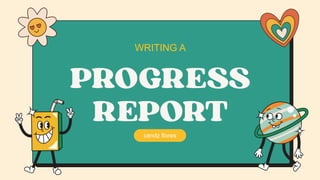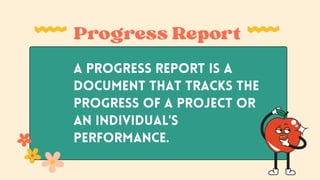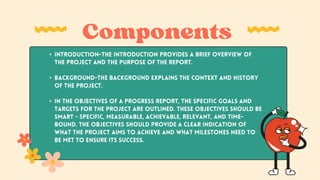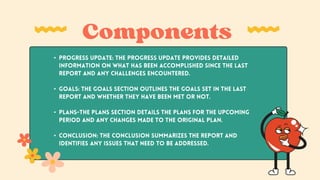Writing a Progress Report.pptx
Download as pptx, pdf0 likes180 views
Teachers can use this presentation to engage students and help them better understand how to write a progress report. It is an ideal resource for teachers who want to provide their students with an engaging lesson on progress reports.
1 of 8
Download to read offline








Ad
Recommended
A Guide for Qualitative Research Topic Selection.pdf
A Guide for Qualitative Research Topic Selection.pdfCendz Flores
╠²
This guide outlines a needs analysis process for selecting a qualitative research topic by conducting interviews within a school community. It details steps for preparing and conducting interviews, including identifying interviewees, creating questions, and analyzing responses. The goal is to identify relevant challenges and needs to inform impactful research topics.Types of Print Media (Media and Information Literacy)
Types of Print Media (Media and Information Literacy)Cendz Flores
╠²
The document outlines an assignment for students to explore various sections of a library and analyze print media, including books, newspapers, and magazines. Each student is assigned a specific section and follows a series of steps to gather details, describe the materials, analyze their style, and reflect on their findings. The completed reports are due on Thursday, with a draft submission required by 11:00 PM the prior day.Pre-Industrial Age to Information Age.pptx
Pre-Industrial Age to Information Age.pptxCendz Flores
╠²
The document outlines the historical evolution of media from the pre-industrial age to the information age, detailing key forms such as cave paintings, the printing press, and social media platforms. It discusses the impact of these media on societal norms and communication practices, highlighting both positive and negative effects on individual behavior and social dynamics. The content emphasizes the importance of responsible media usage in today's digital landscape.News Writing.pptx
News Writing.pptxCendz Flores
╠²
This document provides an overview of key concepts in news writing such as the components of a news article like the headline, lead, and inverted pyramid structure. It also discusses characteristics of a strong lead such as being concise, compelling, and answering the 5W's and H as well as different types of leads like the summary, quotation, question, and descriptive lead. The document concludes by explaining how to write a nut graph to provide context for a quotation lead.Functions of Communication.pptx
Functions of Communication.pptxCendz Flores
╠²
The document explores the various purposes of communication, including regulation and control, social interaction, information dissemination, emotional expression, and motivation. It highlights that communication is essential for establishing and maintaining relationships while also conveying facts and emotions. Additionally, the document suggests that communication serves to inspire and persuade others.Lesson 101_Research Hypothesis.pdf
Lesson 101_Research Hypothesis.pdfCendz Flores
╠²
This document outlines a lesson plan aimed at high school and college students to understand the fundamentals of research, including its meaning, objectives, and the role of motivation. The lesson involves discussions, examples from various fields, and activities designed to engage students and reflect on personal interests in research. An assessment task is included to encourage students to explore a research topic of their choice and identify its associated objectives and motivations.Introduction to Communication.pptx
Introduction to Communication.pptxCendz Flores
╠²
The document discusses communication as the exchange of information, ideas, thoughts, and feelings using various mediums. It highlights key models of communication, particularly the Shannon-Weaver model, which outlines the roles of sender, message, receiver, and noise, while emphasizing the dynamic nature of communication as a mutual process. Additionally, it explores the significance of effective communication in personal, academic, and professional contexts.Research Title_1.pptx
Research Title_1.pptxCendz Flores
╠²
The document provides guidelines for formulating effective quantitative research titles, emphasizing the importance of concise and clear titles that represent the study's focus and significance. It outlines characteristics of a well-crafted title, including length, capitalization, and avoidance of certain terms, and offers examples of research titles along with their corresponding problems, variables, and respondents. The document specifically discusses the study of attitudes toward sustainable practices among members of a grade 11 environmental club in Cebu City, highlighting the key variables and respondents involved.Research Problem_1.pptx
Research Problem_1.pptxCendz Flores
╠²
The document outlines the importance of selecting a relevant research problem, highlighting the differentiation between external and internal criteria for evaluation. Key sources for identifying research problems include theory, practitioners, personal experience, and relevant literature. The document further emphasizes the necessity of ethical considerations, community support, and the researcher's qualifications in formulating a strong research problem.Research Problem.pptx
Research Problem.pptxCendz Flores
╠²
This document discusses the characteristics of effective research problems and how to identify them. It states that effective research problems are specific, measurable, achievable, relevant, and time-bound (SMART). It provides examples of research problems that demonstrate these characteristics. The document also lists top sources for identifying research problems, such as reviewing literature, staying informed on current events and trends, attending professional conferences, and consulting experts in the field.Introduction to Quantitative Research.pptx
Introduction to Quantitative Research.pptxCendz Flores
╠²
This document discusses quantitative research, which involves collecting and analyzing numerical data to identify patterns, relationships, and trends. Quantitative research focuses on measurable variables and uses statistical analysis of large sample sizes to draw objective, generalizable conclusions. Common data collection methods include experiments, observation, and structured surveys. Statistical tools are used to analyze data and identify correlations in order to test hypotheses. Quantitative research has various applications in fields like medicine, psychology, economics and education by providing empirical evidence to inform decision-making and support theories.Qualitative Research .pptx
Qualitative Research .pptxCendz Flores
╠²
The document discusses the differences between qualitative and quantitative research, highlighting the use of non-numerical versus numerical data and different methodological approaches. It provides examples of qualitative research studies, including ethnographic studies of the Igorot people and narratives of migration experiences among overseas Filipino workers. It emphasizes the importance of selecting appropriate research methods based on the research question and context, taking into account various factors like data collection, analysis, and ethical considerations.Research Respondents.pptx
Research Respondents.pptxCendz Flores
╠²
The document discusses the concept of population in terms of sampling methods, describing both probability and non-probability sampling techniques. It details specific methods like simple random sampling, systematic sampling, and stratified random sampling, as well as the use of Slovin's formula for calculating sample size. The document emphasizes methods to reduce sample bias and provides basic calculations for determining intervals and sample sizes.Research Presentation.pptx
Research Presentation.pptxCendz Flores
╠²
The document outlines key strategies for delivering impactful research paper presentations, focusing on title defenses and oral defenses. It emphasizes the importance of preparation in addressing potential questions about the research project, including its title, rationale, objectives, and methodology. Additionally, it highlights the necessity of consulting institutional guidelines for specific requirements and structures.Reflective Journal.pptx
Reflective Journal.pptxCendz Flores
╠²
The reflective journal details the author's experience with public speaking anxiety during a class presentation. Although initially nervous, the author learned valuable insights about preparation, audience perception, and self-regulation techniques that helped manage anxiety. The experience concluded with a sense of accomplishment and a commitment to continue improving public speaking skills.Position Paper.pdf
Position Paper.pdfCendz Flores
╠²
The document defines a position paper as a formal document that presents an individual's or organization's stance on a specific issue, outlining beliefs and proposed solutions. It includes essential parts such as an introduction, background information, arguments, counterarguments, recommendations, and a conclusion, aimed at persuading the audience. An example discusses the importance of increasing access to education in developing countries, highlighting its benefits for economic development, health outcomes, and gender equality.Reaction Paper-Review-Critique Paper.pptx
Reaction Paper-Review-Critique Paper.pptxCendz Flores
╠²
The document provides information on writing reaction papers, reviews, and critiques by defining each type of writing and explaining their purposes, typical lengths, and focuses. It distinguishes reaction papers as personal responses to texts, reviews as assessments of works, and critiques as evaluations of works within their fields. The document offers examples of potential topics for each type of writing and outlines their common elements and structures to help writers effectively communicate their thoughts.Interactive Lesson Plan_Research Problem.pdf
Interactive Lesson Plan_Research Problem.pdfCendz Flores
╠²
The interactive lesson plan focuses on teaching students how to write a research problem by identifying its components, including main problems and subproblems. It guides students through various activities aimed at developing a good research problem, including peer reviews and further research assignments. The lesson emphasizes the importance of specificity, relevance, and feasibility in crafting effective research inquiries.Theoretical Background.pptx
Theoretical Background.pptxCendz Flores
╠²
The document discusses the significance of a well-structured theoretical background in qualitative research, illustrating its role as a roadmap for the study by linking existing theories to research questions. It outlines key components of a theoretical framework, particularly emphasizing expectancy theory and equity theory, and their relevance to understanding student support service utilization. Additionally, it highlights the importance of related literature in providing context and supporting findings in research.Summarizing a Variety of Academic Texts.pptx
Summarizing a Variety of Academic Texts.pptxCendz Flores
╠²
The document outlines the importance and techniques of summarization in academic writing, emphasizing its role in conveying key ideas efficiently. Key techniques include identifying main ideas, paraphrasing, outlining, and using visual tools like concept maps. Regular exercise is highlighted as a beneficial example, demonstrating both physical and mental health improvements through effective summarization.Language Used in Academic Texts from Various Disciplines.pptx
Language Used in Academic Texts from Various Disciplines.pptxCendz Flores
╠²
This document examines the characteristics and conventions of language used in academic texts across various disciplines, emphasizing the importance of understanding these differences for effective academic writing. It highlights how language varies in terms of terminology, sentence structure, writing style, tone, and referencing conventions, which are crucial for establishing credibility and conveying complex ideas. Different fields such as sciences, humanities, and social sciences each have their own specific language features that need to be adhered to in order to effectively communicate research findings.Qualitative Research.pptx
Qualitative Research.pptxCendz Flores
╠²
The document compares qualitative and quantitative research methods, highlighting that qualitative research uses non-numerical data and emphasizes interpretive approaches, while quantitative research relies on numerical data and statistical approaches. It discusses various qualitative methods such as ethnography and case studies, emphasizing the flexibility of qualitative design compared to the structured nature of quantitative design. Additionally, it notes the importance of evaluating the suitability of different methods based on research questions, resources, and ethical considerations.How to Customize Quotation Layouts in Odoo 18
How to Customize Quotation Layouts in Odoo 18Celine George
╠²
Customizing quotation layouts in Odoo 18 allows businesses to personalize their quotations to match branding or specific requirements. This can include adding logos, custom fields, or modifying headers and footers. 2025 June Year 9 Presentation: Subject selection.pptx
2025 June Year 9 Presentation: Subject selection.pptxmansk2
╠²
2025 June Year 9 Presentation: Subject selectionFilipino 9 Maikling Kwento Ang Ama Panitikang Asiyano
Filipino 9 Maikling Kwento Ang Ama Panitikang Asiyanosumadsadjelly121997
╠²
Filipino 9 Maikling Kwento Ang Ama Panitikang AsiyanoECONOMICS, DISASTER MANAGEMENT, ROAD SAFETY - STUDY MATERIAL [10TH]
ECONOMICS, DISASTER MANAGEMENT, ROAD SAFETY - STUDY MATERIAL [10TH]SHERAZ AHMAD LONE
╠²
This study material for Class 10th covers the core subjects of Economics, Disaster Management, and Road Safety Education, developed strictly in line with the JKBOSE textbook. It presents the content in a simplified, structured, and student-friendly format, ensuring clarity in concepts. The material includes reframed explanations, flowcharts, infographics, and key point summaries to support better understanding and retention. Designed for classroom teaching and exam preparation, it aims to enhance comprehension, critical thinking, and practical awareness among students.Code Profiling in Odoo 18 - Odoo 18 ║¦║¦▀ús
Code Profiling in Odoo 18 - Odoo 18 ║¦║¦▀úsCeline George
╠²
Profiling in Odoo identifies slow code and resource-heavy processes, ensuring better system performance. Odoo code profiling detects bottlenecks in custom modules, making it easier to improve speed and scalability.YSPH VMOC Special Report - Measles Outbreak Southwest US 6-14-2025.pptx
YSPH VMOC Special Report - Measles Outbreak Southwest US 6-14-2025.pptxYale School of Public Health - The Virtual Medical Operations Center (VMOC)
╠²
BLUF:
The Texas outbreak has slowed down, but sporadic cases continue to emerge in Kansas, Oklahoma, and New Mexico.
Elsewhere in the US, we continue to see signs of acceleration due to outbreaks outside the Southwest (North Dakota, Montana, and Colorado) and travel-related cases. Measles exposures due to travel are expected to pose a significant challenge throughout the summer.
The U.S. is on track to exceed its 30-year high for measles cases (1,274) within the next two weeks.
Here is the latest update:
CURRENT CASE COUNT: 919
ÔÇóTexas: 744 (+2) (55% of cases are in Gaines County).
ÔÇóNew Mexico: 81 (83% of cases are from Lea County).
ÔÇóOklahoma: 20 (+2)
ÔÇóKansas: 74 (+5) (38.89% of the cases are from Gray County).
HOSPITALIZATIONS: 104
ÔÇó Texas: 96 (+2) ÔÇô This accounts for 13% of all cases in Texas.
ÔÇó New Mexico: 7 ÔÇô This accounts for 9.47% of all cases in New Mexico.
ÔÇó Kansas: 3 ÔÇô This accounts for 5.08% of all cases in the state of Kansas.
DEATHS: 3
ÔÇóTexas: 2 ÔÇô This is 0.27% of all cases in Texas.
ÔÇóNew Mexico: 1 ÔÇô This is 1.23% of all cases in New Mexico.
US NATIONAL CASE COUNT: 1,197
INTERNATIONAL SPREAD
ÔÇóMexico: 2337 (+257), 5 fatalities
ÔÇÆChihuahua, Mexico: 2,179 (+239) cases, 4 fatalities, 7 currently hospitalized.
ÔÇóCanada: 3,207 (+208), 1 fatality
ÔÇÆOntario Outbreak, Canada: 2,115 (+74) cases, 158 hospitalizations, 1 fatality.
ÔÇÆAlberta, Canada: 879(+118) cases, 5 currently hospitalized.Tanja Vujicic - PISA for Schools contact Info
Tanja Vujicic - PISA for Schools contact InfoEduSkills OECD
╠²
Tanja Vujicic, Senior Analyst and PISA for SchoolÔÇÖs Project Manager at the OECD spoke at the OECD webinar 'Turning insights into impact: What do early case studies reveal about the power of PISA for Schools?' on 20 June 2025
PISA for Schools is an OECD assessment that evaluates 15-year-old performance on reading, mathematics, and science. It also gathers insights into studentsÔÇÖ learning environment, engagement and well-being, offering schools valuable data that help them benchmark performance internationally and improve education outcomes. A central ambition, and ongoing challenge, has been translating these insights into meaningful actions that drives lasting school improvement. More Related Content
More from Cendz Flores (14)
Research Problem_1.pptx
Research Problem_1.pptxCendz Flores
╠²
The document outlines the importance of selecting a relevant research problem, highlighting the differentiation between external and internal criteria for evaluation. Key sources for identifying research problems include theory, practitioners, personal experience, and relevant literature. The document further emphasizes the necessity of ethical considerations, community support, and the researcher's qualifications in formulating a strong research problem.Research Problem.pptx
Research Problem.pptxCendz Flores
╠²
This document discusses the characteristics of effective research problems and how to identify them. It states that effective research problems are specific, measurable, achievable, relevant, and time-bound (SMART). It provides examples of research problems that demonstrate these characteristics. The document also lists top sources for identifying research problems, such as reviewing literature, staying informed on current events and trends, attending professional conferences, and consulting experts in the field.Introduction to Quantitative Research.pptx
Introduction to Quantitative Research.pptxCendz Flores
╠²
This document discusses quantitative research, which involves collecting and analyzing numerical data to identify patterns, relationships, and trends. Quantitative research focuses on measurable variables and uses statistical analysis of large sample sizes to draw objective, generalizable conclusions. Common data collection methods include experiments, observation, and structured surveys. Statistical tools are used to analyze data and identify correlations in order to test hypotheses. Quantitative research has various applications in fields like medicine, psychology, economics and education by providing empirical evidence to inform decision-making and support theories.Qualitative Research .pptx
Qualitative Research .pptxCendz Flores
╠²
The document discusses the differences between qualitative and quantitative research, highlighting the use of non-numerical versus numerical data and different methodological approaches. It provides examples of qualitative research studies, including ethnographic studies of the Igorot people and narratives of migration experiences among overseas Filipino workers. It emphasizes the importance of selecting appropriate research methods based on the research question and context, taking into account various factors like data collection, analysis, and ethical considerations.Research Respondents.pptx
Research Respondents.pptxCendz Flores
╠²
The document discusses the concept of population in terms of sampling methods, describing both probability and non-probability sampling techniques. It details specific methods like simple random sampling, systematic sampling, and stratified random sampling, as well as the use of Slovin's formula for calculating sample size. The document emphasizes methods to reduce sample bias and provides basic calculations for determining intervals and sample sizes.Research Presentation.pptx
Research Presentation.pptxCendz Flores
╠²
The document outlines key strategies for delivering impactful research paper presentations, focusing on title defenses and oral defenses. It emphasizes the importance of preparation in addressing potential questions about the research project, including its title, rationale, objectives, and methodology. Additionally, it highlights the necessity of consulting institutional guidelines for specific requirements and structures.Reflective Journal.pptx
Reflective Journal.pptxCendz Flores
╠²
The reflective journal details the author's experience with public speaking anxiety during a class presentation. Although initially nervous, the author learned valuable insights about preparation, audience perception, and self-regulation techniques that helped manage anxiety. The experience concluded with a sense of accomplishment and a commitment to continue improving public speaking skills.Position Paper.pdf
Position Paper.pdfCendz Flores
╠²
The document defines a position paper as a formal document that presents an individual's or organization's stance on a specific issue, outlining beliefs and proposed solutions. It includes essential parts such as an introduction, background information, arguments, counterarguments, recommendations, and a conclusion, aimed at persuading the audience. An example discusses the importance of increasing access to education in developing countries, highlighting its benefits for economic development, health outcomes, and gender equality.Reaction Paper-Review-Critique Paper.pptx
Reaction Paper-Review-Critique Paper.pptxCendz Flores
╠²
The document provides information on writing reaction papers, reviews, and critiques by defining each type of writing and explaining their purposes, typical lengths, and focuses. It distinguishes reaction papers as personal responses to texts, reviews as assessments of works, and critiques as evaluations of works within their fields. The document offers examples of potential topics for each type of writing and outlines their common elements and structures to help writers effectively communicate their thoughts.Interactive Lesson Plan_Research Problem.pdf
Interactive Lesson Plan_Research Problem.pdfCendz Flores
╠²
The interactive lesson plan focuses on teaching students how to write a research problem by identifying its components, including main problems and subproblems. It guides students through various activities aimed at developing a good research problem, including peer reviews and further research assignments. The lesson emphasizes the importance of specificity, relevance, and feasibility in crafting effective research inquiries.Theoretical Background.pptx
Theoretical Background.pptxCendz Flores
╠²
The document discusses the significance of a well-structured theoretical background in qualitative research, illustrating its role as a roadmap for the study by linking existing theories to research questions. It outlines key components of a theoretical framework, particularly emphasizing expectancy theory and equity theory, and their relevance to understanding student support service utilization. Additionally, it highlights the importance of related literature in providing context and supporting findings in research.Summarizing a Variety of Academic Texts.pptx
Summarizing a Variety of Academic Texts.pptxCendz Flores
╠²
The document outlines the importance and techniques of summarization in academic writing, emphasizing its role in conveying key ideas efficiently. Key techniques include identifying main ideas, paraphrasing, outlining, and using visual tools like concept maps. Regular exercise is highlighted as a beneficial example, demonstrating both physical and mental health improvements through effective summarization.Language Used in Academic Texts from Various Disciplines.pptx
Language Used in Academic Texts from Various Disciplines.pptxCendz Flores
╠²
This document examines the characteristics and conventions of language used in academic texts across various disciplines, emphasizing the importance of understanding these differences for effective academic writing. It highlights how language varies in terms of terminology, sentence structure, writing style, tone, and referencing conventions, which are crucial for establishing credibility and conveying complex ideas. Different fields such as sciences, humanities, and social sciences each have their own specific language features that need to be adhered to in order to effectively communicate research findings.Qualitative Research.pptx
Qualitative Research.pptxCendz Flores
╠²
The document compares qualitative and quantitative research methods, highlighting that qualitative research uses non-numerical data and emphasizes interpretive approaches, while quantitative research relies on numerical data and statistical approaches. It discusses various qualitative methods such as ethnography and case studies, emphasizing the flexibility of qualitative design compared to the structured nature of quantitative design. Additionally, it notes the importance of evaluating the suitability of different methods based on research questions, resources, and ethical considerations.Recently uploaded (20)
How to Customize Quotation Layouts in Odoo 18
How to Customize Quotation Layouts in Odoo 18Celine George
╠²
Customizing quotation layouts in Odoo 18 allows businesses to personalize their quotations to match branding or specific requirements. This can include adding logos, custom fields, or modifying headers and footers. 2025 June Year 9 Presentation: Subject selection.pptx
2025 June Year 9 Presentation: Subject selection.pptxmansk2
╠²
2025 June Year 9 Presentation: Subject selectionFilipino 9 Maikling Kwento Ang Ama Panitikang Asiyano
Filipino 9 Maikling Kwento Ang Ama Panitikang Asiyanosumadsadjelly121997
╠²
Filipino 9 Maikling Kwento Ang Ama Panitikang AsiyanoECONOMICS, DISASTER MANAGEMENT, ROAD SAFETY - STUDY MATERIAL [10TH]
ECONOMICS, DISASTER MANAGEMENT, ROAD SAFETY - STUDY MATERIAL [10TH]SHERAZ AHMAD LONE
╠²
This study material for Class 10th covers the core subjects of Economics, Disaster Management, and Road Safety Education, developed strictly in line with the JKBOSE textbook. It presents the content in a simplified, structured, and student-friendly format, ensuring clarity in concepts. The material includes reframed explanations, flowcharts, infographics, and key point summaries to support better understanding and retention. Designed for classroom teaching and exam preparation, it aims to enhance comprehension, critical thinking, and practical awareness among students.Code Profiling in Odoo 18 - Odoo 18 ║¦║¦▀ús
Code Profiling in Odoo 18 - Odoo 18 ║¦║¦▀úsCeline George
╠²
Profiling in Odoo identifies slow code and resource-heavy processes, ensuring better system performance. Odoo code profiling detects bottlenecks in custom modules, making it easier to improve speed and scalability.YSPH VMOC Special Report - Measles Outbreak Southwest US 6-14-2025.pptx
YSPH VMOC Special Report - Measles Outbreak Southwest US 6-14-2025.pptxYale School of Public Health - The Virtual Medical Operations Center (VMOC)
╠²
BLUF:
The Texas outbreak has slowed down, but sporadic cases continue to emerge in Kansas, Oklahoma, and New Mexico.
Elsewhere in the US, we continue to see signs of acceleration due to outbreaks outside the Southwest (North Dakota, Montana, and Colorado) and travel-related cases. Measles exposures due to travel are expected to pose a significant challenge throughout the summer.
The U.S. is on track to exceed its 30-year high for measles cases (1,274) within the next two weeks.
Here is the latest update:
CURRENT CASE COUNT: 919
ÔÇóTexas: 744 (+2) (55% of cases are in Gaines County).
ÔÇóNew Mexico: 81 (83% of cases are from Lea County).
ÔÇóOklahoma: 20 (+2)
ÔÇóKansas: 74 (+5) (38.89% of the cases are from Gray County).
HOSPITALIZATIONS: 104
ÔÇó Texas: 96 (+2) ÔÇô This accounts for 13% of all cases in Texas.
ÔÇó New Mexico: 7 ÔÇô This accounts for 9.47% of all cases in New Mexico.
ÔÇó Kansas: 3 ÔÇô This accounts for 5.08% of all cases in the state of Kansas.
DEATHS: 3
ÔÇóTexas: 2 ÔÇô This is 0.27% of all cases in Texas.
ÔÇóNew Mexico: 1 ÔÇô This is 1.23% of all cases in New Mexico.
US NATIONAL CASE COUNT: 1,197
INTERNATIONAL SPREAD
ÔÇóMexico: 2337 (+257), 5 fatalities
ÔÇÆChihuahua, Mexico: 2,179 (+239) cases, 4 fatalities, 7 currently hospitalized.
ÔÇóCanada: 3,207 (+208), 1 fatality
ÔÇÆOntario Outbreak, Canada: 2,115 (+74) cases, 158 hospitalizations, 1 fatality.
ÔÇÆAlberta, Canada: 879(+118) cases, 5 currently hospitalized.Tanja Vujicic - PISA for Schools contact Info
Tanja Vujicic - PISA for Schools contact InfoEduSkills OECD
╠²
Tanja Vujicic, Senior Analyst and PISA for SchoolÔÇÖs Project Manager at the OECD spoke at the OECD webinar 'Turning insights into impact: What do early case studies reveal about the power of PISA for Schools?' on 20 June 2025
PISA for Schools is an OECD assessment that evaluates 15-year-old performance on reading, mathematics, and science. It also gathers insights into studentsÔÇÖ learning environment, engagement and well-being, offering schools valuable data that help them benchmark performance internationally and improve education outcomes. A central ambition, and ongoing challenge, has been translating these insights into meaningful actions that drives lasting school improvement. IIT KGP Quiz Week 2024 Sports Quiz (Prelims + Finals)
IIT KGP Quiz Week 2024 Sports Quiz (Prelims + Finals)IIT Kharagpur Quiz Club
╠²
The document outlines the format for the Sports Quiz at Quiz Week 2024, covering various sports & games and requiring participants to Answer without external sources. It includes specific details about question types, scoring, and examples of quiz questions. The document emphasizes fair play and enjoyment of the quiz experience.This is why students from these 44 institutions have not received National Se...
This is why students from these 44 institutions have not received National Se...Kweku Zurek
╠²
This is why students from these 44 institutions have not received National Service PIN codes (LIST)CRYPTO TRADING COURSE BY FINANCEWORLD.IO
CRYPTO TRADING COURSE BY FINANCEWORLD.IOAndrewBorisenko3
╠²
Unlock the Secrets of Crypto Trading with FinanceWorld.io!
Are you ready to dive into the exciting world of cryptocurrency trading? This comprehensive course by FinanceWorld.io is designed for beginners and intermediate traders who want to master the fundamentals of crypto markets, technical analysis, risk management, and trading strategies.
What youÔÇÖll learn:
Introduction to blockchain and cryptocurrencies
How crypto markets work
Setting up wallets and trading accounts securely
Understanding exchanges and order types
Reading charts and technical analysis basics
Essential indicators and market signals
Risk management and portfolio diversification
Real-life trading strategies and case studies
Common mistakes and how to avoid them
Who should view this course?
Aspiring crypto traders
Investors seeking additional income sources
Anyone curious about the future of decentralized finance
Why FinanceWorld.io?
Our experts make complex concepts simple, helping you gain the confidence to navigate volatile markets and capitalize on opportunities.
Ready to start your crypto journey?
View this slide deck now and take your first step towards becoming a successful crypto trader with FinanceWorld.io!June 2025 Progress Update With Board Call_In process.pptx
June 2025 Progress Update With Board Call_In process.pptxInternational Society of Service Innovation Professionals
╠²
---
June 25 ISSIP Event - slides in process
20250618 PPre-Event Presentation Summary - Progress Update with Board Series June 25
ISSIP Website Upcoming Events Description: https://issip.org/event/semi-annual-issip-progress-call/
Register here (even if you cannot attend live online, all who register will get link to recording and slides post-event): https://docs.google.com/forms/d/e/1FAIpQLSdThrop1rafOCo4PQkYiS2XApclJuMjYONEHRMGBsceRdcQqg/viewform
This pre-event presentation: /slideshow/june-2025-progress-update-with-board-call_in-process-pptx/280718770
This pre-event recording: https://youtu.be/Shjgd5o488o
---Learning Styles Inventory for Senior High School Students
Learning Styles Inventory for Senior High School StudentsThelma Villaflores
╠²
Learning styles inventory, learning strategies, visual learners, auditory learners, kinesthetic learners, tactile learners, read/write learnersPests of Maize: An comprehensive overview.pptx
Pests of Maize: An comprehensive overview.pptxArshad Shaikh
╠²
Maize is susceptible to various pests that can significantly impact yields. Key pests include the fall armyworm, stem borers, cob earworms, shoot fly. These pests can cause extensive damage, from leaf feeding and stalk tunneling to grain destruction. Effective management strategies, such as integrated pest management (IPM), resistant varieties, biological control, and judicious use of chemicals, are essential to mitigate losses and ensure sustainable maize production.Photo chemistry Power Point Presentation
Photo chemistry Power Point Presentationmprpgcwa2024
╠²
Photochemistry is the branch of chemistry that deals with the study of chemical reactions and processes initiated by light.
Photochemistry involves the interaction of light with molecules, leading to electronic excitation. Energy from light is transferred to molecules, initiating chemical reactions.
Photochemistry is used in solar cells to convert light into electrical energy.
It is used Light-driven chemical reactions for environmental remediation and synthesis. Photocatalysis helps in pollution abatement and environmental cleanup. Photodynamic therapy offers a targeted approach to treating diseases It is used in Light-activated treatment for cancer and other diseases.
Photochemistry is used to synthesize complex organic molecules.
Photochemistry contributes to the development of sustainable energy solutions.INDUCTIVE EFFECT slide for first prof pharamacy students
INDUCTIVE EFFECT slide for first prof pharamacy studentsSHABNAM FAIZ
╠²
The inductive effect is the electron-withdrawing or electron-donating effect transmitted through sigma (¤â) bonds in a molecule due to differences in electronegativity between atoms.
---
ƒö╣ Definition:
The inductive effect is the permanent shifting of electrons in a sigma bond caused by the electronegativity difference of atoms, resulting in partial charges within the molecule.How to use _name_search() method in Odoo 18
How to use _name_search() method in Odoo 18Celine George
╠²
In Odoo, the _name_search() method is used to implement or extend the logic for searching records by name or other fields. It is typically invoked when a user types into a many-to-one or many-to-many field's search box in the user interface. YSPH VMOC Special Report - Measles Outbreak Southwest US 6-14-2025.pptx
YSPH VMOC Special Report - Measles Outbreak Southwest US 6-14-2025.pptxYale School of Public Health - The Virtual Medical Operations Center (VMOC)
╠²
June 2025 Progress Update With Board Call_In process.pptx
June 2025 Progress Update With Board Call_In process.pptxInternational Society of Service Innovation Professionals
╠²
Ad
Writing a Progress Report.pptx
- 4. IMPORTANCE
- 6. ÔÇó ÔÇó ÔÇó
